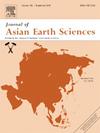IF 2.7
3区 地球科学
Q2 GEOSCIENCES, MULTIDISCIPLINARY
引用次数: 0
摘要
页岩中碳氢化合物/沥青的存在使得对储层性质进行准确表征具有挑战性。溶剂萃取有助于揭示早期成熟湖相页岩油藏的真实孔隙结构并评估可移动石油分布。本研究采用总有机碳、光学显微镜、Rock-Eval 热解、X 射线衍射、扫描电子显微镜、气体吸附和高压注汞压力实验等方法,研究了从中国鄂尔多斯盆地三叠系长 7 组采集的提取和未提取页岩样品的岩相、地球化学和岩石物理特征。结果表明,与原始状态相比,溶剂萃取后页岩的微孔、中孔和大孔体积、比表面积、平均孔径和孔隙度的变化有显著差异,这表明富含有机质的早熟页岩的孔隙结构在很大程度上被保留的石油和残余沥青所掩盖。溶剂萃取通常通过去除占据大量孔隙空间的可萃取有机物(EOM)来增加孔隙度。不过,溶剂萃取也可能受到多种因素的影响,导致孔隙度降低。影响溶剂萃取过程的主要因素有:可萃取有机物的去除、溶剂与基质的相互作用、粘土膨胀以及沉积结构与孔隙系统的耦合效应。此外,利用孔隙度的变化来表示页岩中的可移动含油量比 S1 和总孔隙体积的变化更有意义。这项研究有利于准确表征页岩孔隙结构,精确评估湖相页岩的可移动含油量。本文章由计算机程序翻译,如有差异,请以英文原文为准。

Characterization of pore structure before and after solvent extraction: A case study of lacustrine shales in the Triassic Chang 7 Formation, Ordos Basin, Northern China
The presence of hydrocarbons/bitumen in shales makes accurate characterization of reservoir properties challenging. Solvent extraction helps reveal the true pore structures and assess the movable oil distributions in early mature lacustrine shale oil reservoirs. In the present study, total organic carbon, optical microscopy, Rock-Eval pyrolysis, X-ray diffraction, scanning electron microscope, gas adsorption, and high-pressure mercury injection pressure experiments were performed to investigate the petrographic, geochemical and petrophysical characteristics of extracted and nonextracted shale samples that were collected from the Triassic Chang 7 Member in the Ordos Basin, China. The results revealed that changes in the micro-, meso-, and macropore volumes; specific surface area; average pore diameters and porosities of the shales significantly differ after solvent extraction compared with their original states, which indicates that the pore structures of early-mature, organic-rich shales are largely concealed by the retained oil and residual bitumen. Solvent extraction generally increases porosity by removing extractable organic matter (EOM), which occupies a sizeable pore space. Solvent extraction may, however, also be affected by several factors, resulting in reduced porosity. The main factors influencing the solvent extraction process are the removal of EOM, solvent–kerogen interactions, clay swelling, and the coupling effects of the sedimentary structure and pore system. In addition, the use of changes in porosity to indicate the movable oil content in shales is more meaningful than the changes in S1 and total pore volume are. This study is beneficial for the accurate characterization of shale pore structures and precise assessments of the movable oil contents of lacustrine shales.
求助全文
通过发布文献求助,成功后即可免费获取论文全文。
去求助
来源期刊

Journal of Asian Earth Sciences
地学-地球科学综合
CiteScore
5.90
自引率
10.00%
发文量
324
审稿时长
71 days
期刊介绍:
Journal of Asian Earth Sciences has an open access mirror journal Journal of Asian Earth Sciences: X, sharing the same aims and scope, editorial team, submission system and rigorous peer review.
The Journal of Asian Earth Sciences is an international interdisciplinary journal devoted to all aspects of research related to the solid Earth Sciences of Asia. The Journal publishes high quality, peer-reviewed scientific papers on the regional geology, tectonics, geochemistry and geophysics of Asia. It will be devoted primarily to research papers but short communications relating to new developments of broad interest, reviews and book reviews will also be included. Papers must have international appeal and should present work of more than local significance.
The scope includes deep processes of the Asian continent and its adjacent oceans; seismology and earthquakes; orogeny, magmatism, metamorphism and volcanism; growth, deformation and destruction of the Asian crust; crust-mantle interaction; evolution of life (early life, biostratigraphy, biogeography and mass-extinction); fluids, fluxes and reservoirs of mineral and energy resources; surface processes (weathering, erosion, transport and deposition of sediments) and resulting geomorphology; and the response of the Earth to global climate change as viewed within the Asian continent and surrounding oceans.
 求助内容:
求助内容: 应助结果提醒方式:
应助结果提醒方式:


